Tesco Bundle
How Did Tesco Become a Retail Titan?
From a modest market stall to a global retail empire, the Tesco SWOT Analysis reveals a fascinating journey. This brief history of Tesco company explores how a simple vision of "pile it high and sell it cheap" transformed the retail landscape. Discover the key milestones and strategic decisions that propelled Tesco to its current dominance.
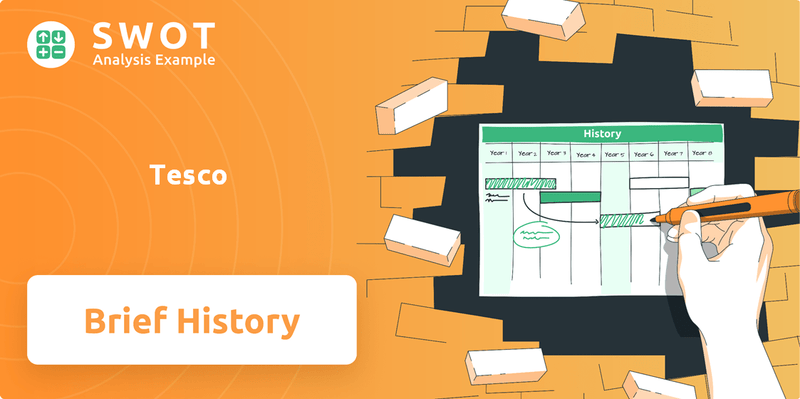
This exploration of Tesco's history, from its founding by Jack Cohen in 1919 to its current market leadership, provides valuable insights. Understanding the Tesco timeline, including its early years and expansion, offers a glimpse into the evolution of its business model. Examining Tesco's stores and key milestones helps to understand its profound impact on the retail industry and its global presence history.
What is the Tesco Founding Story?
The story of the [Company Name], a retail giant, begins with its founding by Jack Cohen. His vision and entrepreneurial spirit laid the groundwork for what would become one of the world's largest retailers. Understanding the early days of the company provides crucial context for its later success and its impact on the retail landscape.
Jack Cohen's journey started in 1919, shortly after his service in the Royal Flying Corps. He saw an opportunity to provide affordable goods, a strategy that would define the company's early years. This focus, coupled with a keen understanding of market needs, propelled the business forward.
Jack Cohen, son of Polish immigrants, founded [Company Name] in 1919. He started with a market stall in London, selling war-surplus groceries. The company's name and first store marked significant milestones.
- In 1919, Jack Cohen began his venture with a market stall in Hackney, East End of London, selling war-surplus groceries. This marked the beginning of the [Company Name] story.
- The name 'Tesco' was coined in 1924. Jack Cohen combined the initials of Thomas Edward Stockwell (TES) with his surname (CO). This branding decision was a key step in establishing the company's identity.
- The first [Company Name] shop opened in September 1931 at 54 Watling Avenue, Burnt Oak, Edgware, Middlesex. This physical store expanded the company's reach beyond the market stall.
- By 1939, the company had grown to include 100 stores. This rapid expansion showed the effectiveness of the company's business model and its appeal to customers.
The initial funding for [Company Name] came from Jack Cohen's 'demob money' after World War I. He used this to buy surplus goods like fish paste and golden syrup. This early investment in affordable products was a cornerstone of the company's early success. For further insights into the company's operations, consider exploring the Revenue Streams & Business Model of Tesco.
Tesco SWOT Analysis
- Complete SWOT Breakdown
- Fully Customizable
- Editable in Excel & Word
- Professional Formatting
- Investor-Ready Format
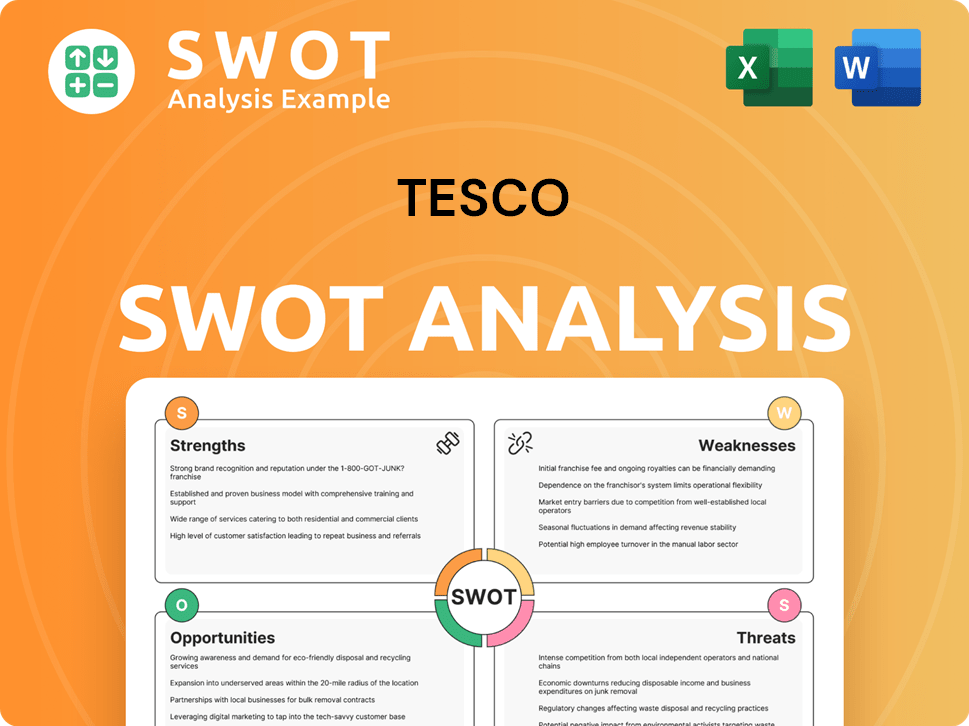
What Drove the Early Growth of Tesco?
The early growth of the Tesco company was marked by rapid expansion and strategic acquisitions. This period saw the transformation from market stalls to pioneering self-service stores and supermarkets. The company's journey, from its inception to becoming a major player in the retail industry, is a testament to its founder's vision and strategic foresight.
Jack Cohen opened his first shop in September 1931, following his initial market stall experiments. Inspired by the self-service concept in the United States, Cohen aimed to bring this innovation to Britain. The first self-service store opened in St Albans in 1948, a significant step in the
The 1950s and 1960s saw significant growth through organic expansion and strategic acquisitions. Key acquisitions during this period included Williamson's stores in 1957, Harrow Stores outlets in 1959, and Irwins stores in 1960. The company's growth trajectory was further fueled by acquisitions like Charles Phillips stores in 1964 and the Victor Value chain in 1968.
The first true supermarket, offering both dry goods and fresh foods, opened in Maldon in 1956. In the early 1960s, the company began diversifying its offerings by adding apparel and homeware sections. This strategic move laid the groundwork for the first hypermarket, which opened in Crawley in 1968. By the time of Jack Cohen's death in 1979, the company had hundreds of supermarkets and hypermarkets across Great Britain.
In 1947, the company was floated on the London Stock Exchange as Tesco Stores (Holdings) Limited, allowing it to raise capital for further expansion. By 1979, the annual turnover reached £1 billion, highlighting the company's remarkable growth. This financial success underscored the effectiveness of its expansion strategies and market positioning.
Tesco PESTLE Analysis
- Covers All 6 PESTLE Categories
- No Research Needed – Save Hours of Work
- Built by Experts, Trusted by Consultants
- Instant Download, Ready to Use
- 100% Editable, Fully Customizable
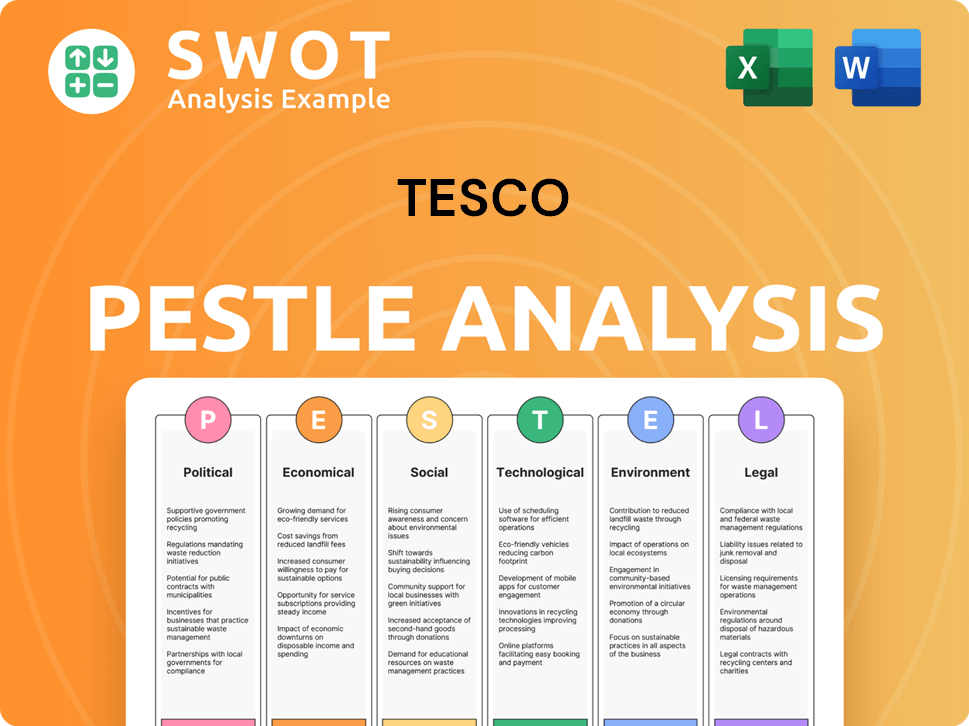
What are the key Milestones in Tesco history?
The Tesco company has a rich Tesco history marked by several key milestones that have shaped its journey from a market stall to a global retail giant. This brief history of Tesco highlights its evolution and impact on the retail industry.
| Year | Milestone |
|---|---|
| 1919 | Jack Cohen, the Tesco founder, starts selling groceries from a market stall in London. |
| 1929 | The first Tesco stores opens in Edgware, North London. |
| 1930s | Tesco expands through acquisitions and new store openings. |
| 1974 | Tesco pioneers barcode scanning, revolutionizing checkout processes. |
| 1995 | The Tesco Clubcard is launched, transforming customer loyalty programs. |
| 2000 | Tesco.com is launched, marking a significant step into online retail. |
Tesco has consistently embraced innovation to stay ahead in the competitive retail landscape. A significant innovation was the introduction of the Clubcard in 1995, which provided valuable data insights and enhanced customer loyalty. The early adoption of barcode scanning in 1974 also set a new standard for efficiency in the retail sector.
The Tesco Clubcard, introduced in 1995, revolutionized customer loyalty by collecting data on consumer behavior. This data allowed Tesco to personalize offers and improve its understanding of customer preferences.
Tesco was an early adopter of barcode scanning technology in 1974, enhancing checkout efficiency. This innovation accelerated the speed of transactions and improved inventory management across Tesco stores.
The launch of Tesco.com in 2000 made Tesco one of the first major retailers to offer online shopping. This expansion allowed Tesco to reach a broader customer base and adapt to changing consumer habits.
In the late 1990s and early 2000s, Tesco expanded its operations globally, entering markets across Europe and Asia. This expansion increased Tesco's international presence and diversified its revenue streams.
The 'Save to Invest' programme contributed approximately £510 million in savings in FY 2024/25. This initiative helped to offset operating cost inflation and improve financial performance.
Tesco has focused on sustainability, achieving a 65% reduction in Scope 1 and 2 emissions since 2015/16. The company aims for carbon neutrality by 2035 and net zero across its supply chain by 2050.
Despite its successes, Tesco has faced numerous challenges throughout its history. Increased competition from discount retailers and changing consumer preferences have impacted its market share. Economic uncertainties and market downturns have also presented significant hurdles.
Increased competition from discount retailers such as Aldi and Lidl has put pressure on Tesco's market share. This has led Tesco to adapt its strategies to remain competitive in the market.
Changes in consumer preferences, including a growing demand for value and convenience, have required Tesco to evolve. Tesco has responded by investing in new product lines and enhancing its online services.
Economic uncertainties and market downturns have posed challenges to Tesco's financial performance. In April 2025, Tesco acknowledged increased competitive intensity, leading to a forecast of lower adjusted operating profit for the fiscal year 2025/26.
Tesco has experienced fluctuations in its market share due to intense competition and changing consumer behaviors. The company has implemented restructuring and rebranding efforts to regain its market leadership.
Tesco has faced challenges related to operational cost inflation, which has impacted its profitability. The 'Save to Invest' programme was implemented to mitigate these rising costs.
Disruptions to the supply chain have presented challenges to Tesco's operations, affecting product availability and costs. The company has worked to strengthen its supply chain resilience.
Tesco Business Model Canvas
- Complete 9-Block Business Model Canvas
- Effortlessly Communicate Your Business Strategy
- Investor-Ready BMC Format
- 100% Editable and Customizable
- Clear and Structured Layout
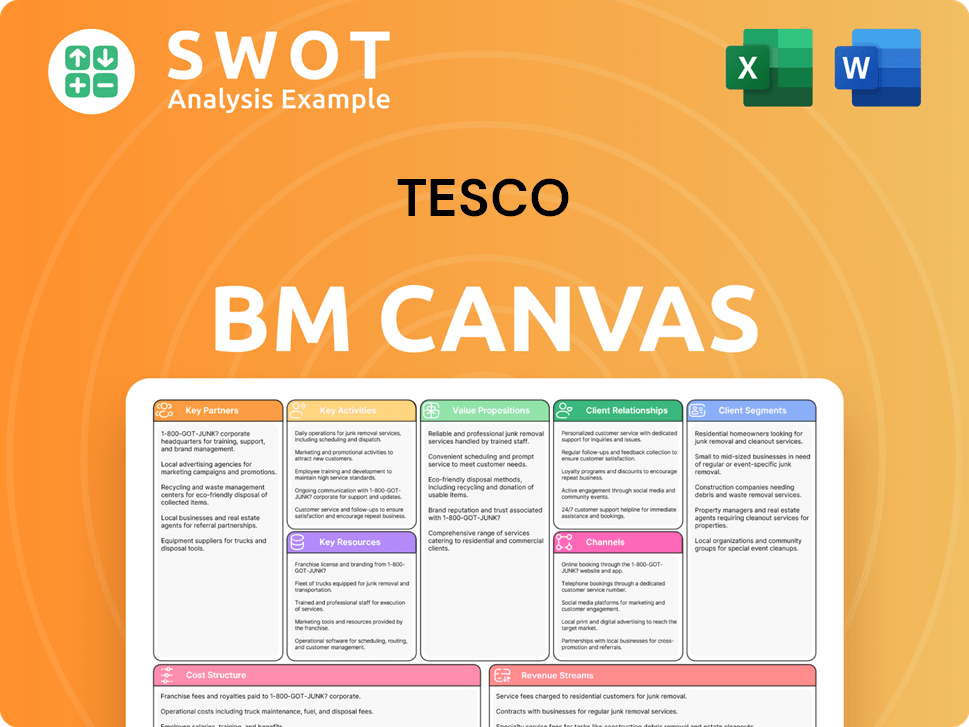
What is the Timeline of Key Events for Tesco?
The Tesco history is a story of growth and adaptation, starting from a market stall in 1919 to a global retail giant. From its early days under Tesco founder Jack Cohen, the company expanded rapidly, embracing self-service and supermarkets. Key milestones include the launch of the Clubcard in 1995, the introduction of online shopping in 2000, and significant international expansion. In recent years, the company has focused on sustainability and digital innovation to maintain its market leadership.
| Year | Key Event |
|---|---|
| 1919 | Jack Cohen founded Tesco as a market stall in Hackney, London. |
| 1924 | The Tesco brand name was created, combining 'TES' and 'CO'. |
| 1931 | The first Tesco store opened in Burnt Oak, Edgware, Middlesex. |
| 1939 | Tesco expanded to 100 stores across the UK. |
| 1947 | Tesco Stores (Holdings) Limited was listed on the London Stock Exchange. |
| 1948 | The first self-service store opened in St Albans. |
| 1956 | The first true Tesco supermarket opened in Maldon, Essex. |
| 1968 | Tesco opened its first hypermarket in Crawley. |
| 1974 | Tesco began selling gasoline and pioneered barcode scanning. |
| 1979 | Annual turnover reached £1 billion. |
| 1995 | The Tesco Clubcard was launched, revolutionizing customer loyalty. |
| 1997 | Tesco re-entered the Irish market and launched its first 'Extra' hypermarket. |
| 2000 | Tesco.com was launched for online shopping. |
| 2004 | International expansion into markets like China and the United States began. |
| 2013 | Tesco pledged to reduce food waste and promote sustainability. |
| 2020 | Tesco adapted operations to support communities during the COVID-19 pandemic. |
| 2024/25 | Group sales reached £63.6 billion, with adjusted operating profit at £3.13 billion, and a UK market share of 28.3%. |
| May 2025 | Tesco aims to capture over 30% of the UK grocery market share. |
Tesco aims to increase its UK grocery market share to over 30% driven by investments in value, quality, and digital capabilities. The company is enhancing its digital offerings, with improvements to its online experience. This includes the expansion of its Whoosh rapid-delivery service to over 1,500 stores. The online launch of F&F clothing is also scheduled for the year ahead.
For the fiscal year 2025/26, Tesco anticipates an adjusted operating profit between £2.7 billion and £3.0 billion. Despite competitive pressures, the company projects free cash flow within its medium-term guidance range of £1.4 billion to £1.8 billion. Tesco is committed to its capital return program, with a new £1.45 billion share buyback program to be completed by April 2026.
Tesco is committed to sustainability, aiming for carbon-neutral operations by 2035 and net-zero across its supply chain by 2050. The company has already exceeded its 2025 target for reducing Scope 1 and 2 emissions. These efforts align with the original vision of providing value while embracing sustainable and digitally-driven retail experiences.
Tesco is focusing on enhancing its digital capabilities to improve the customer experience. This includes increased personalization and improvements to its online platform. The expansion of the Whoosh rapid-delivery service and the launch of Tesco Marketplace, offering over 400,000 third-party products, are key elements of this strategy.
Tesco Porter's Five Forces Analysis
- Covers All 5 Competitive Forces in Detail
- Structured for Consultants, Students, and Founders
- 100% Editable in Microsoft Word & Excel
- Instant Digital Download – Use Immediately
- Compatible with Mac & PC – Fully Unlocked
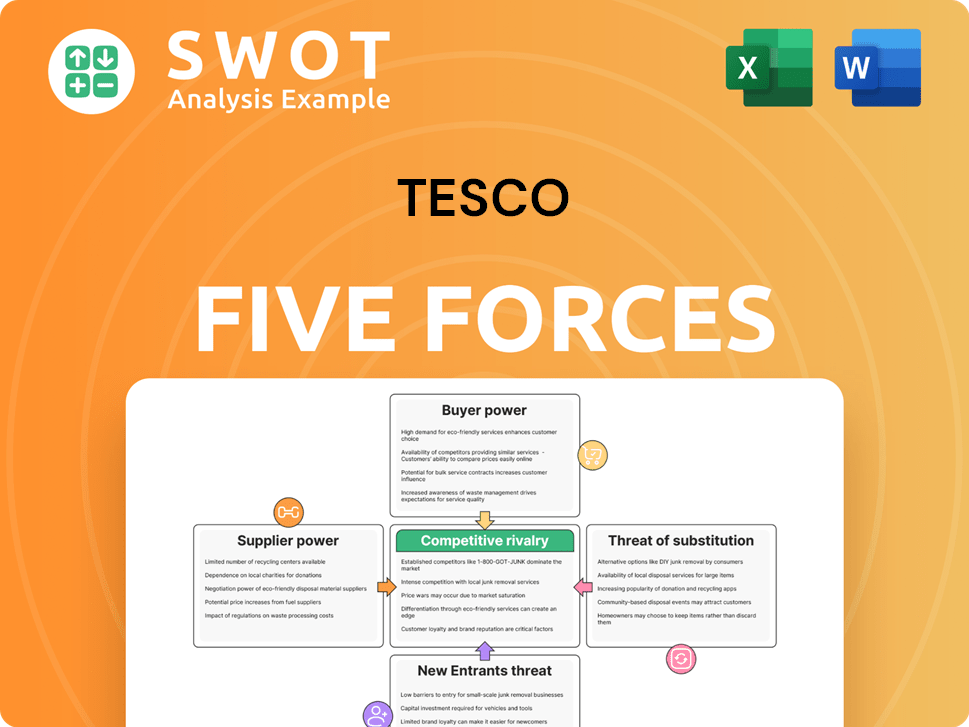
Related Blogs
- What is Competitive Landscape of Tesco Company?
- What is Growth Strategy and Future Prospects of Tesco Company?
- How Does Tesco Company Work?
- What is Sales and Marketing Strategy of Tesco Company?
- What is Brief History of Tesco Company?
- Who Owns Tesco Company?
- What is Customer Demographics and Target Market of Tesco Company?
Disclaimer
All information, articles, and product details provided on this website are for general informational and educational purposes only. We do not claim any ownership over, nor do we intend to infringe upon, any trademarks, copyrights, logos, brand names, or other intellectual property mentioned or depicted on this site. Such intellectual property remains the property of its respective owners, and any references here are made solely for identification or informational purposes, without implying any affiliation, endorsement, or partnership.
We make no representations or warranties, express or implied, regarding the accuracy, completeness, or suitability of any content or products presented. Nothing on this website should be construed as legal, tax, investment, financial, medical, or other professional advice. In addition, no part of this site—including articles or product references—constitutes a solicitation, recommendation, endorsement, advertisement, or offer to buy or sell any securities, franchises, or other financial instruments, particularly in jurisdictions where such activity would be unlawful.
All content is of a general nature and may not address the specific circumstances of any individual or entity. It is not a substitute for professional advice or services. Any actions you take based on the information provided here are strictly at your own risk. You accept full responsibility for any decisions or outcomes arising from your use of this website and agree to release us from any liability in connection with your use of, or reliance upon, the content or products found herein.